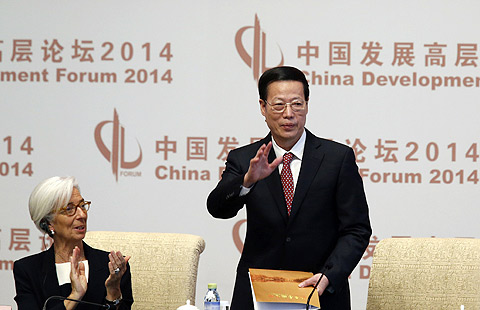New benchmark rate system is necessary
Updated: 2014-03-24 07:34
By Yi Xianrong (China Daily)
|
|||||||||||
For example, the recently popular Yu'ebao, a kind of Internet financial product, seems to have broken government curbs on deposit rates and will increase investors' returns, but it is a form of financial resources self-circulation within the financial system. Its creation will help break the current interest rates regulations and push for rates marketization, but its positive effect on the real economy will be very limited.
|
 |
 |
Quite a few financial innovations have not played a role in promoting the development of the real economy. Instead, their creation, by further extending the money chain, has resulted in excessive expansion of credit and thus weakened the role of the financial sector in supporting the real economy and considerably increased the risks for the whole financial system. For example, the current excessive credit expansion by some banks, a serious financial disintermediation, the prevalence of shadow banks, the financing vehicles of local governments, an unreasonable financing structure, as well as booming Internet financial business, real estate bubbles and the two-track interest rate system are all related to the serious distortion of the pricing mechanism in the domestic financial market and the sluggish marketized reform of interest rates.
All these mean that marketized rate reform in China should not be just accelerating deposit rates regulation alone: The country should also try to address thorny institutional problems.
In developed economies such as the United States and European countries, benchmark rates regulated by central banks usually comprise an official benchmark and a marketized benchmark, with both acting as benchmark prices to guide the price changes in their financial markets. However, in China, only one-year deposit and lending rates act as the benchmark.
Unlike developed economies where their financial market prices can influence their benchmark rates, the prices of financial products in China are all based on its benchmark rates.
For example, the prices of China's government bonds yield curve are not based on non-risk returns, but based on its benchmark rates. As for the country's one-year deposit and lending rates, it remains unclear what determinants, whether a subjective decision of the leaders or a compromise of interests distribution or data analyses, lead to their final adoption.
The author is a researcher with the Institute of Finance and Banking with the Chinese Academy of Social Sciences. The views do not necessarily reflect those of China Daily.
Related Stories
China to open interest rate in one or two years 2014-03-11 11:16
Major banks maintain deposit interest rate 2014-01-26 09:16
China trials new interest rate reform 2013-12-09 18:37
China to launch new vehicle to free interest rates 2013-11-22 22:16
New steps to free up interest rates 2013-09-27 07:07
Today's Top News
China, the Netherlands seek closer co-op
Crimea is part of Russia
Images may help solve jet mystery
Obamas wowed by China
Xi leaves Beijing for first trip to Europe
Beijing beefs up hunt for missing jet
Putin signs law on Crimea accession
Australia to resume ocean search for missing jet
Hot Topics
Lunar probe , China growth forecasts, Emission rules get tougher, China seen through 'colored lens', International board,
Editor's Picks

|

|

|

|

|

|





